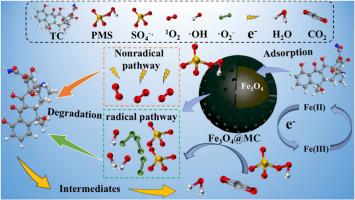核-壳Fe3O4@mesoporous碳复合材料通过过氧单硫酸盐活化降解四环素
IF 3.5
3区 化学
Q2 CHEMISTRY, INORGANIC & NUCLEAR
引用次数: 0
摘要
过氧单硫酸根(PMS)是一种强氧化剂,可产生多种自由基。磁性Fe3O4具有易于回收和分离的优点,可作为PMS活化处理污染物的多相催化剂。但其固有的团聚和金属离子浸出特性限制了其进一步利用。为了提高Fe3O4催化剂的催化效率和稳定性,制备了核壳Fe3O4@mesoporous碳(Fe3O4@MC)复合材料,通过PMS活化去除四环素(TC)。Fe3O4@MC具有明显的球形结构和介孔结构,平均粒径为280 nm,平均表面积为212.95 m2 g−1。在Fe3O4@MC/PMS体系中,MC壳层与内部Fe3O4核的协同作用显著提高了催化性能。考察了催化剂用量和种类、PMS用量、TC浓度、溶液pH、温度、共存阴离子和水基质等重要因素对降解过程的影响。结果,Fe3O4@MC在60分钟内对TC的降解效率为75.9%,连续5次循环后循环效率可保持87.6%。提出了PMS的激活机制,包括自由基和非自由基途径,并有助于降解TC。Fe3O4@MC复合材料将促进降解TC催化剂的发展,在废水处理中具有良好的前景。本文章由计算机程序翻译,如有差异,请以英文原文为准。

Core-shell Fe3O4@mesoporous carbon composite for tetracycline degradation via peroxymonosulfate activation
Peroxymonosulfate (PMS) as a powerful oxidant could produce multiple radicals. Due to the advantages of easy recovery and separation, magnetic Fe3O4 can be regarded as heterogeneous catalyst in PMS activation for pollutants treatment. However, the intrinsic properties of agglomeration and metal ion leaching limit the further utilization. To promote the catalytic efficiency and stability of Fe3O4 catalyst, core-shell Fe3O4@mesoporous carbon (Fe3O4@MC) composite is prepared to eliminate tetracycline (TC) via PMS activation. Fe3O4@MC exhibits obviously spherical morphology, mesoporous structural with the mean particles size and surface area of 280 nm and 212.95 m2 g−1. In Fe3O4@MC/PMS system, the synergistic interaction of MC shell and inner Fe3O4 core results in significantly improvement of the catalytic performance. The effect of important factors including catalyst dose and type, PMS dosage, TC concentration, pH of solution, temperature, co-existing anions and water matrices on degradation process are evaluated. As a result, Fe3O4@MC delivers a considerable degradation efficiency of 75.9 % for TC within 60 min, and the cycle efficiency can maintain 87.6 % after five consecutive cycles. PMS activation mechanism including radicals and nonradical pathways is proposed and contributes to the degradation of TC. The remarkable Fe3O4@MC composite would promote the development of catalysts for TC degradation and present favorable prospectives in wastewater treatment.
求助全文
通过发布文献求助,成功后即可免费获取论文全文。
去求助
来源期刊

Journal of Solid State Chemistry
化学-无机化学与核化学
CiteScore
6.00
自引率
9.10%
发文量
848
审稿时长
25 days
期刊介绍:
Covering major developments in the field of solid state chemistry and related areas such as ceramics and amorphous materials, the Journal of Solid State Chemistry features studies of chemical, structural, thermodynamic, electronic, magnetic, and optical properties and processes in solids.
 求助内容:
求助内容: 应助结果提醒方式:
应助结果提醒方式:


